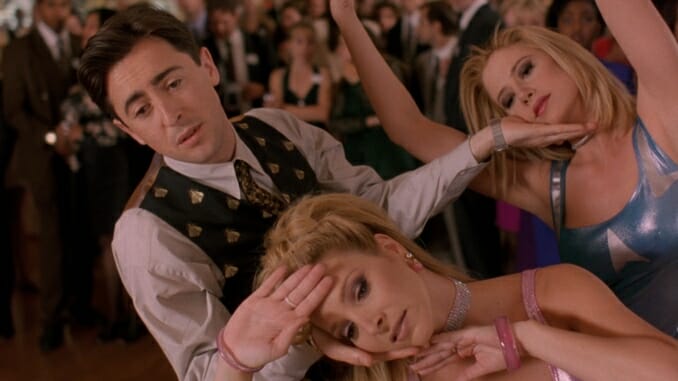We Need More Unexpected Dance Sequences in Films

When you peel back all of the trappings, movies are just a bunch of people playing pretend in front of a camera. That’s not to undermine the importance of film; cinema opens minds and reminds us of our shared humanity. My point is more about the inherently constructed nature of movies. They provide the chance for a bunch of adults to tap into their imaginations, whether they’re the people creating or consuming movies. We’re making a space for us to be serious or silly, escape reality or analyze it. Either way, it’s an inherently child-like endeavor, in the best sense of the word.
That’s why the unexplained dance routine is one of my favorite non-sequiturs in film. We’re not talking about choreography in musicals or movies that are specifically about dance (sorry to Center Stage or Showgirls), but the moments that feel a little unreal, even jarring. We usually receive no explanation as to why these characters suddenly all know the same dance moves. These routines feel almost like the director breaking the fourth wall, reminding us that we’re all playing the same game of make believe.
Romy and Michele’s High School Reunion turned 25 recently, and the frothy comedy boasts not just one, but two dance sequences. In the first, Romy (Mira Sorvino, putting on a voice that Elizabeth Holmes probably envies) and Michele (Lisa Kudrow) bop along to “Stayin’ Alive” at an L.A. club. The final dance, though, is a thing of beauty: the duo cut a rug barefoot alongside former high school nerd Sandy Frink (Alan Cumming) in a bizarre, emotive routine. Neither scene particularly furthers the plot, other than showing that busting out coordinated dance moves just means it’s a Tuesday night for Romy and Michele. The numbers also had a practical purpose, pushing the movie just over the 90 minute mark.
Just two years later, She’s All That busted in with its own pair of dance scenes. We get Matthew Lillard—playing the deluded reality TV star Brock Hudson—clearing the dance floor at a high school party in order to show off in front of all the teens. Not only does he fully commit to every gyration, but the party attendees are clearly unimpressed. It’s an effective and hilarious way to show what a self-obsessed weirdo Brock is.
The second number in She’s All That doesn’t have that same sense of purpose in terms of teaching us anything about the characters, other than perhaps setting the scene: prom. But I’ll be thoroughly impressed if I hear about a prom where a bunch of teens bust out a choreographed routine (or not; despite my love of dance numbers in movies, I find real-life flash mobs annoying). Anyway, the Campus D.J. (Usher) beckons the high schoolers to the floor, Pied Piper style, to perform a dance that he taught them along to “The Rockafeller Skank” by Fatboy Slim. Did Usher round up a bunch of bored high school seniors in the gym during homeroom to practice? Or is this some sort of elective? Either way, it’s iconic.
Along with the new millennium came something I like to call the Sex Dance, so named because making love is so fantastic that these characters simply have to celebrate! With dance! It’s oddly wholesome. We have Andy (Steve Carrell), the titular 40-Year-Old Virgin, singing and shimmying along to “Aquarius/Let the Sunshine In” after he’s finally had sex. Then there’s Joseph Gordon-Levitt’s Tom in 500 Days of Summer. Following his first time having sex with Summer, he frolics through Los Angeles to “You Make My Dreams” by Hall & Oates, even being joined by a cartoon bluebird at one point. Noticeably absent: Summer (Zooey Deschanel). This is all about him (and that goes for the rest of the film, too).
While the unexplained dance routine is still deployed in comedies—in the 2016 Ghostbusters, for example—its use in dramedies and more serious films has become more prominent within the last decade. Ex Machina’s dance moment heightens the surreality of the film, which follows Blue Book employee Caleb Smith (Domhnall Gleeson) as he goes to his employer Nathan’s (Oscar Isaacs) uber modern home and is asked to test the humanity of a robot named Ava (Alicia Vikander). As Caleb gets more twisted in Nathan’s creepy AI web, he’s treated to a performance by Nathan and his robot servant, Kyoko. Bathed in red light and soundtracked by Oliver Cheatham’s “Get Down Saturday Night,” it’s truly a sight to behold. Caleb stands there, dumbstruck by the bizarre scene, and audience members can’t help but feel just as baffled.